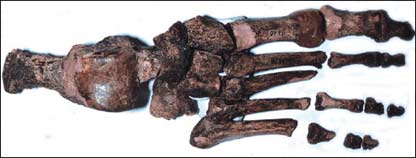A study that examined leg bones of ancient humans determined that the invention of shoes reduced the need for strong and flexible toes

Shoes with soles came into widespread use 40,000-20,000 years ago and caused the weakening of the human toes. This is what the American anthropologist Eric Trinkaus claims, who studied dozens of leg bones of ancient humans. The invention of shoes with soles, Prof. Trinkaus claims, reduced the need for strong and flexible toes and affected the structure of the four "less important" toes; Only the toe remained as it was.
While humans living in northern climates began covering their feet to insulate themselves from the cold earth as early as 500 years ago, foot covering similar to modern shoes was likely a much later innovation. Archaeologists have difficulty finding evidence of ancient shoes because raw materials from plants and animals, from which the prehistoric shoes were made, are materials that decay quickly. "The oldest shoes found are from about 9,000 years ago," said Prof. Trinkaus, who works at Washington University in St. Louis.
However, after examining the leg bones of modern humans (Homo sapiens) and Neanderthals from 100,000 years ago to 10,000 years ago, Prof. Trinkaus claims that he was able to determine at what period wearing shoes became the norm.
He discovered that the four toes of the Neanderthals and Homo sapiens who lived in the Middle Paleolithic period (100,000 to 40,000 years ago) were thicker, and hence stronger, than the toes of the people who lived in the Upper Paleolithic period (45,000 to 18,000 years ago).
Specifically, Trinkaus observed that the greatest physiological change occurred 26,000 years ago. "I found that the bones in the toes of people from this period were much less strong than the toes of their ancestors, although their foot bones remained large and strong," Trinkaus said. The study appeared in the journal "Journal of Archaeological Science".
The thickness of the fingers is not related to the climate
Life without shoes requires stronger toes, Trinkaus added, because "when you walk barefoot, you grab the ground with your toes out of a natural reflex." Since hard-soled shoes improve both grip and balance, he claims, those who wear them develop weaker toes. "We previously argued that thick toes and hands are associated with greater blood supply in cold climates, but this hypothesis is not supported by the findings."
Advertisement The appearance of the shoes occurred during a period that Trinkaus describes as a "well-documented archaeological explosion", in which other important inventions were recorded. Paul Mallars, a prehistory expert at Cambridge University, agrees that there were "dramatic changes" in human development at that time. "From 35,000 years ago onwards we see the first art, the first stone tools and the first personal ornaments and jewelry," said Mallars and added that during this period "there is much evidence that people performed more complex tasks with skins, with special stone tools for cleaning and with awls for piercing. In light of all these changes, it will not be a surprise to find out that better shoes have started to be produced," said Prof. Mallars.
For news at the BBC
The news is courtesy of Haaretz, Walla News
